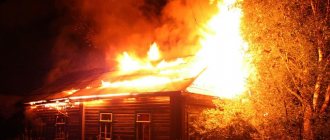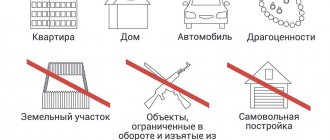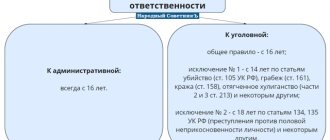Sergey Alekseev Lawyer, website author
Expert commentary
When qualifying a crime, only actual damage is taken into account; lost profits are not taken into account.
It is also worth noting that in the event of intentional damage to someone else’s property, if repairing the item is impossible or impractical, the amount of damage is calculated as the difference in price before and after the damage.
Another commentary on Article 167 of the Criminal Code of the Russian Federation
1. The subject of the crime in question can only be someone else’s property that has an exchangeable, commodity value.
Destruction and damage to special types of property or natural resources in their natural state, directly specified in the criminal law, require qualification under other articles of the Criminal Code of the Russian Federation, for example, under Art. 243 (destruction of critical habitats for organisms listed in the Red Book of the Russian Federation); Art. 261 (destruction or damage to forests); Art. 267 (rendering unusable means of transport or means of communication). Destruction or damage to material property can also be the result of terrorism (Article 205) and vandalism (Article 214 of the Criminal Code of the Russian Federation). In all of the above cases, the perpetrator faces independent grounds for criminal liability, different from Art. 167 of the Criminal Code of the Russian Federation. 2. From the objective side, the crime is expressed in the destruction or damage of someone else’s property.
The destruction of an object is the complete loss of its consumer properties and economic value, bringing it into a state in which it cannot be used for its intended purpose at all, and the properties it has lost cannot be restored.
Damage is a partial, incomplete loss of an object’s consumer properties and economic value, a significant reduction in the possibility of using it for its intended purpose. With the necessary labor and financial costs for repairing and restoring a thing damaged by a criminal, it is able to regain temporarily and partially lost useful qualities and properties, allowing it to be used with varying degrees of efficiency for its intended functional purpose.
3. Destruction or damage to someone else’s property as its harmful consequences leads to the infliction of significant material damage on the owner, the amount of which as “significant” should be determined according to the same criteria as a similar sign in relation to the composition provided for in Art. 166 of the Criminal Code (see commentary to Part 3 of Article 166 of the Criminal Code).
4. From the subjective side, destruction or damage to someone else’s property can be committed with both direct and indirect intent. The motives and purposes of the act do not have qualifying significance for the application of Art. 167 of the Criminal Code have no influence. However, if the destruction or damage to someone else’s property (for example, an expensive bank safe) is committed with the aim of overcoming barriers to the storage of material assets in order to steal them, the act requires additional qualification under the relevant article of the Criminal Code on liability for theft as a completed or unfinished attack (Art. Art. 29, 30 CC).
5. According to Part 1 of Art. 167 of the Criminal Code may be held liable by persons who have reached the age of 16, and under Part 2 - by those who have reached the age of 14.
6. Part 2 art.
167 constructs a qualified crime if the destruction or damage to someone else’s property was committed out of hooligan motives by arson, explosion or other generally dangerous method, or negligently resulted in the death of a person or other grave consequences (for example, the inability to carry out production activities for a long period of time due to the destruction equipment or necessary raw materials and supplies, failure to meet deadlines for the execution of a large commercial contract by a business entity, etc.).
In this case, a crime resulting in the death of a person through negligence is a crime committed with two forms of guilt (see commentary to Article 27 of the Criminal Code of the Russian Federation), which combines intentional guilt in relation to the destruction or damage of someone else’s property and careless guilt in the form of frivolity or negligence (see commentary to Article 26 of the Criminal Code of the Russian Federation) - to the death of a person.
Hooligan motives as a motive for criminal activity are commented above in relation to the analysis of the corpus delicti of premeditated murder, provided for in paragraph “i” of Part 2 of Art. 105 of the Criminal Code of the Russian Federation.
conclusions
If you suffer a loss of up to 5 thousand rubles, the culprit will suffer administrative punishment, if more than 5 thousand rubles. and the amount of damage for you will be tangible, he will be brought to criminal liability for committing destruction or damage to someone else’s property.
The Code of Administrative Offenses provides for a maximum penalty of a fine of up to 500 rubles. , and the Criminal Code - imprisonment for up to 5 years, if the perpetrator has not previously been prosecuted for other atrocities.
Important! The statute of limitations for liability for damage caused to someone else's property under an administrative penalty is 3 months, under a criminal penalty - up to 6 years.
Where to file a complaint
In the event that a citizen discovers that a crime has been committed against his property, it is necessary to submit an application to law enforcement agencies, which are the police, the prosecutor's office
Please note that in this case it is better to go straight to the police, since the prosecutor’s office will forward your complaint there (they are not involved in checking such reports). If you send a complaint to the prosecutor, the time frame for checking this fact will be delayed.
The statement indicates Article 167 or 168 of the Criminal Code of the Russian Federation, depending on whether the act was intentional or careless. Initially, it may be considered one category, and after verification it is reclassified into another.
Important! Speaking of where to complain, if an administrative violation has been committed, then you also need to contact the police. To compensate for the amount of damage caused, it is necessary to contact the judicial authorities.
When filing a claim in court, you will need to provide evidence of how much the damaged property is worth. The amount may be indicated in the purchase and sale agreement, receipts and other documentation. If the car was purchased on credit, then a loan agreement is provided, indicating the full amount. The assessment of losses is carried out in accordance with civil law.
Drawing up an act of damage to someone else's property
Authorized officials are involved in drawing up acts. In case of damage to the property of a legal entity - employees of the company or institution, in case of damage to the property of a private person, for example, an apartment and interior items, employees of the servicing management company. In addition to the owner of the damaged premises, neighbors are often involved in drawing up the act, invited as witnesses. The document contains several required parts:
- name, number, date and place of compilation;
- information about the organization that suffered damage or the private owner of the damaged property;
- a detailed description of the damaged property - from the address of the apartment to the make and model of damaged equipment;
- preliminary damage assessment;
- the cause of damage and details of the culprit, if known;
- data and signatures of all participants in drawing up the act.
How to determine the extent of damage
To assign punishment and compensation for damage to the victim, the cost of the damage must be correctly assessed.
For this purpose, the investigator orders an examination.
It is carried out by an organization that has the appropriate license.
The expert takes into account such points as:
- how much the item costs on the market at the moment;
- what is the percentage of depreciation of the property;
- Is it possible to restore or will I have to purchase a new item?
Most often, as part of a criminal case, an examination of the following property is carried out:
- Cars. If the damage is minor, then it is easy to assess the damage. Problems arise when the car is completely destroyed after a fire. Then the year of manufacture of the car, mileage, time spent in ownership, information about the accident in which the car was involved, and the cost of a car with similar characteristics must be taken into account.
- Household appliances, musical equipment, phones, tablets.
It is advisable that the victim keep the receipt for the purchase. Then the examination will take into account the year of production and the real price of the item. If there is no receipt, then the average price in stores at the time of purchase is taken as the basis. - House, building, store and other real estate. If the property is completely lost, then the price according to the cadastre on the day the offense was committed is taken. When a part of the house is damaged (windows, doors, roof, internal contents), then the prices for finishing materials in stores, the price for repair services, and the likelihood of restoration to its original condition are studied.
Luxury items: jewelry, furs, leather, paintings, etc.
Usually a person keeps receipts for these goods, so the expert is guided by the amount for which they were purchased.
Sample statement to the police about property damage.
Main characteristics of crimes involving threats to damage property
The intention of destroying valuables is to intimidate immediately or in the future to damage property that is obviously foreign to the attacker. The crime associated with blackmail about damage to material assets is considered to be realized at the moment when the victim perceives the statements as potential actions.
The intent to damage material assets is considered complete, regardless of the form in which it was received. The legislation considers expression in writing, orally, by gestures, by transmitting a message through third parties, at the moment of actual demonstration of the means by which the specified intention can be carried out. An integral sign of a realized danger is the presence of reliable grounds for fear about the further implementation of received messages.
The threat of destruction is considered as lawlessness, which consists of active actions by attackers aimed at actually intimidating the injured party about the possible destruction of property in any way.
When an application for destruction of property arises, the following persons are considered as the injured party:
- Legal owner;
- Full owner of material assets;
- Persons under whose protection the value is;
- Citizens who are currently using items;
- A second person who is interested in the complete preservation of the property.
Arbitrage practice
Many cases of property damage are intentionally related to conflict situations that arise between people. This is especially common among road users.
One of the high-profile criminal cases is a traffic conflict between two well-known individuals: deputy Igor Amural and former law enforcement officer Sergei Kovalenko.
In connection with the conflict between citizens due to an accident, one of them intentionally caused damage to the property of the second defendant (second part of Article 167 of the Code), in response to which the second participant in the proceedings caused the following types of harm to his opponent:
- Mild harm to health.
- Causing retaliatory damage to a car (the first part of the article under consideration).
Information about which crimes specifically were charged with which of the participants was not disclosed to the public.
The materials of the case under consideration were transferred to the court, but the judicial authority returned them for further investigation due to insufficient evidence.
What is the liability for damaging someone else's property?
The fact is that the law of the Russian Federation provides for liability for damage to someone else’s property, because a citizen is free to dispose of his property as he wants, at his own discretion.
Damage to someone else's property involves causing any damage to the item, usually mechanical (break, tear, set fire, flood, etc.) damage, as a result of which the damaged item loses value, damage to appearance, damage to functionality, rendering the item in a state of complete disrepair , in general, a damaged item loses its estimated value compared to the value before the damage was caused. In some cases, damage implies the complete destruction of a thing without the possibility of its restoration.
The fact is that, in principle, damage to someone else’s property cannot be prohibited at the legislative level, but it is possible to hold the person causing harm accountable.
Firstly, it is necessary to determine who is the causer of the harm, secondly, to assess the damage caused and then to bring the causer to justice.
Based on Article 1064 of the Civil Code of the Russian Federation, damage that was caused to the property of an individual or legal entity is subject to compensation in full and it is the person who caused the damage who compensates for the damage. This is usually what happens, for example, a neighbor crashed your car in the yard, for example, broke the glass with a stick or threw a stone, this action was caught on a surveillance camera. As a result, the culprit is known and he can be brought to justice, at least in court ordered to compensate for the damage for the broken glass, to recover from him the costs of examination and legal expenses, as well as moral damages.
If we classify the types of liability for damage to someone else’s property, then it can be divided into 3 types:
- Administrative responsibility;
- Civil responsibility;
- Criminal liability.
Administrative responsibility
When, as a result of the actions of the culprit, someone else's property worth up to 5 thousand rubles was damaged, he is brought to administrative responsibility.
Examples:
- scratches on the car;
- breaking glass windows, dishes in catering establishments;
- damage to communication cables;
- damage to clothing and other things.
It is important to know! If enough evidence of guilt has been collected, the perpetrator for damaging someone else’s material assets is subject to a fine of 300-500 rubles. The magistrate makes a decision on this, which can be appealed within 10 days from the date the offender receives a copy of it.
Punishment for threat
The criminal law provides for punishment under Article 167 for threats. When the danger of threats is real (a promise to start a fire, to cause physical suffering), then such illegal actions are punishable by:
- fine;
- community and correctional labor;
- administrative arrest.
In rare cases, when the destruction of property is part of another criminal act, the desire to frighten, to cause fear in the victim, in the aggregate will be punished.
These rare violations of the law will be considered:
- compulsion to have sexual intercourse;
- non-compliance with people's rights based on national, religious, racial, social and cultural principles;
- statements addressed to law enforcement officers about violent actions;
- blackmail and extortion;
- actions threatening health with the use of physical violence to prevent the provision of reliable testimony, the preparation of real expert opinions;
- obstruction of professional and economic work required by law;
- forcing the fulfillment or prohibition of the fulfillment of any accepted obligations.
A mandatory element of applying liability measures for an expressed desire to harm someone else’s property is the presence of such actions and a real danger of commission.
According to the disposition of Article 167 of the Criminal Code, the following types of punishment are provided:
- For the first part (intentional complete destruction or partial damage to someone else's property leading to significant harm) - a fine of up to 40 thousand rubles, or in the amount of wages. Either other earnings of the perpetrator (up to three salaries) or performing labor for a period not exceeding 360 hours, correctional labor for a period of up to 1 year, forced labor for a period of up to 2 years, detention for a period of up to 3 months or restriction of freedom for 2 years.
- For the second part (actions with hooligan motives, through fire, using an explosive device, or some other manifestation dangerous to society) - forced labor or restriction of freedom for a period of up to 5 years.
It is necessary to distinguish between the complete destruction of someone else's property and manifestations of vandalism and minor hooliganism with the deliberate destruction of things and objects.
Commentary on Article 167 of the Criminal Code of the Russian Federation
Commentary edited by Rarog A.I.
1. The subject of the crime is someone else’s property. If, during the destruction of one’s own property, significant damage was caused to someone else’s property or to property that was the joint property of the perpetrator and other persons, “the actions of such a person, who wanted the specified consequences to occur or did not want them, but consciously allowed them or treated them indifferently, should be qualified as intentional destruction or damage to someone else’s property” (clause 8 of the Resolution of the Plenum of the Supreme Court of the Russian Federation dated June 5, 2002
“On judicial practice in cases of violation of fire safety rules, destruction or damage to property by arson or as a result of careless handling of fire”).
2. Destruction of property means such an external impact as a result of which the property completely ceases its physical existence (burning, dissolution in acid, complete and irreparable destruction) or is rendered completely unusable for its intended purpose and cannot be restored.
3. Damage should be understood as such a change in the properties of property in which its usefulness is significantly deteriorated and the thing becomes partially or completely unsuitable for economic or other intended use without its repair, restoration and other restorative actions.
4. A prerequisite for the punishability of the analyzed act is the infliction of significant damage. If the victim is a private person, then the amount is assessed as significant according to the rules of Note 2 to Art. 158 of the Criminal Code. The damage caused to the organization is determined by the court taking into account its property status and financial condition.
5. A crime can be committed with direct or indirect intent. The motives and goals of the act do not affect qualifications, with the exception of hooligan motives and those motives and goals that turn the act into a crime of another kind (terrorism, sabotage, etc.).
6. Liability under Part 1 of Art. 167 of the Criminal Code begins at the age of 16.
7. Hooligan motives as qualifying signs of this crime have the same content as in the case of murder (see commentary to paragraph “i” of Part 2 of Article 105 of the Criminal Code).
8. In addition to the directly named arson and explosion, other methods that endanger the life and health of people should be included in the generally dangerous methods in which the law attaches the importance of qualifying characteristics.
9. “The deliberate destruction or damage of individual objects using fire under conditions that exclude its spread to other objects and the emergence of a threat of harm to the life and health of people, as well as other people’s property, must be qualified under Part 1 of Art. 167 of the Criminal Code, if the victim suffered significant damage” (clause 6 of the Resolution of the Plenum of the Supreme Court of the Russian Federation dated June 5, 2002 N 14 “On judicial practice in cases of violation of fire safety rules, destruction or damage to property by arson or as a result of careless handling fire").
10. The third qualifying feature is the negligent infliction of death of a person or other grave consequences, which should include the infliction of serious harm to the health of at least one person, mass poisoning or illness of people, animals, plants, etc.
11. According to Part 2 of Art. 167 of the Criminal Code, liability begins at the age of 14.
Criminal liability
Since July 3, 2016, quite significant amendments have been made to the Russian Criminal Code, according to which (Article No. 167) the minimum permissible loss (damage/destruction of someone else’s property) should be from 5 thousand rubles. (previously - from 2.5 thousand rubles). In this case, the loss caused to the victim must be tangible.
That is, a mandatory factor in qualifying a crime, according to the Russian Criminal Code (Article No. 167), is considered to be the materiality of the loss caused by the perpetrator for the victim.
The Russian Supreme Court directs the judicial authorities to mandatory clarification of the following factors:
- presence of dependents;
- presence of debt obligations to banking institutions;
- living in a full-fledged/inferior family;
- other nuances.
The severity of the damage to the victim must be assessed and confirmed by objective reasons. In this case, the amount of the total loss should not be less than 5 thousand rubles.
How to recover damages
The first step of the victim is to write a statement to the police about the loss or damage of things. The application states to whom and from whom it is being sent: the name of the unit, the victim’s details, address and telephone number.
Then you should describe under what circumstances the offense was committed, when and who discovered it, and indicate the approximate cost of the damage.
If there is any idea who did this, then this should also be noted in the statement. Then the victim must write what she demands: criminal or administrative punishment.
The investigator examines all submitted documents, interviews the victim, witnesses and the offender, or takes action to capture him. Then makes a decision to initiate a case.
The offender can avoid criminal punishment if he voluntarily agrees to make all payments to the victim.
If this does not happen, the investigator issues a decision to initiate criminal proceedings and orders an examination.
After the examination, the victim must file a claim to recover the cost of the items and moral damages.
This can be done regardless of whether criminal or administrative punishment is imposed on the offender.
The claim is filed either with a magistrate (if the price does not exceed 50,000 rubles) or with a civil court at the place of registration. The claim describes the circumstances of the incident, the demands of the victim, and attaches all documentary evidence.
It is advisable that upon the initial discovery of a crime, a property damage report should be drawn up. It can be drawn up by property owners with the participation of representatives of housing and communal services, police officers, firefighters, and medical workers (if damage to health is caused).
The act must include the date, time, place of the offense, a list of damages, the alleged offender, members of the commission, and conclusions drawn based on the examination.
Three copies of the document are required, one of which is handed over to the police and will serve as evidence in court.
A person’s actions that lead to the loss or damage of someone’s property are punishable under an administrative or criminal statute.
It depends on the size of material losses and the severity of the consequences
In this case, it does not matter what was the motive for the crime, it will still not be recognized as a mitigating circumstance.
An example of a property damage report.
You can learn about liability for damage to someone else's property from the video:
https://youtube.com/watch?v=v780_foScb0%3Fecver%3D1
Didn't find the answer to your question? Find out how to solve exactly your problem - call right now:
| Share with friends: |
Did you like the article? Follow site updates or.
Comments:
Civil liability
Criminal liability for violation of the law by damaging someone else’s property occurs in the above cases, but the culprit is obliged to compensate the injured party for losses according to the Code of Administrative Offenses in any case. If it is not possible to voluntarily agree on compensation for the cost of damaged or destroyed items, the victim may file a claim in civil court. If the defendant's guilt is proven, the court will force him to compensate for the damage in full. Read here about compensation for property damage in criminal proceedings.
It is worth noting: the person guilty of damaging someone else’s property may not bear criminal liability in the event of reconciliation with the victim (Article 76 of the Criminal Code of the Russian Federation). The initiator of signing a settlement agreement can be any of the parties to the conflict. In this case, the offender must make amends for the harm caused to the victim. You can read more information about the reconciliation of parties in criminal proceedings.
But you should know that if the amount of damage for an intentional crime is less than 5 thousand, and for an unintentional crime - less than 120 thousand rubles, there is a limitation period of 3 months. If the victim does not go to court within the specified period, he will not be able to recover compensation from the accused.
The amount of damage can be assessed in several ways depending on the individual situation. These methods include:
- Independent examination. It is usually used in case of damage to cars, real estate and expensive equipment.
- Providing a receipt for the purchase of the item. It is used for damage to fur products and other things whose value has not changed since the date of purchase.
- Determination of average market value. It is used in cases where a car, real estate, equipment or other thing, the receipt for which has not been preserved, is completely destroyed. Then the expert takes into account the year of manufacture and technical (and other) characteristics of the property and determines the average market value of such an item.
Based on the cost and quality of property damage, the amount of compensation to the victim is determined.
Find out what to do if your property is destroyed or damaged in the video below.
Liability of minors
In the event that theft, damage to property or another crime is committed by a minor, it is necessary to take into account the provisions of the criminal law regarding the age at which liability may occur. . Until the child reaches fourteen years of age, the parents bear financial responsibility for him
In addition, legal representatives also face punishment in accordance with the protocol drawn up under Article 5.35 of the Code of Administrative Offenses “Improper performance of parental responsibilities.” The document is reviewed by a commission dealing with juvenile affairs. Based on the results of the review, a decision on registration may be made.
Until the child reaches fourteen years of age, the parents bear financial responsibility for him. In addition, legal representatives also face punishment in accordance with the protocol drawn up under Article 5.35 of the Code of Administrative Offenses “Improper performance of parental responsibilities.” The document is reviewed by a commission dealing with juvenile affairs. Based on the results of the review, a decision on registration may be made.
https://youtube.com/watch?v=TFRRxgPGh9M%3Ffeature%3Doembed
When the perpetrator is 14 years old at the time of committing the crime, he bears responsibility independently, including making amends for the harm caused. If the child does not have personal funds, then this responsibility falls on his parents.
Under some articles of administrative legislation, liability is imposed on a person who has reached the age of sixteen. The Criminal Code of the Russian Federation also provides for punishment from the specified age, but when there are qualifying signs, then fourteen-year-olds are brought to justice. In a situation where your property has been damaged, it is better to contact a professional lawyer to help you win your case in court and achieve fair compensation.
The corpus delicti under Article 168
This article of the code contains a list of penalties that apply to a criminal who has destroyed or damaged someone else’s property through negligence.
To qualify such an offense as an act punishable under this article, it is necessary that the crime has the proper ingredients.
The object of a criminal act is a relationship that falls into the category of property. The subject of the crime is property owned by another person, regardless of its type: movable or immovable.
The objective side of such a criminal act implies damage or complete destruction of movable or immovable property. Qualification of actions as such an offense is possible when the damage was caused by careless handling of a source of increased danger.
The subject of a crime can be any sane person who has reached the age of 16 at the time of the commission of the offense. Particular attention is paid to illegal actions committed by an official. Depending on the circumstances of the case, the crime may be classified under Article 286 of the code, which provides for more severe penalties.
Important! An unlawful act can only be committed through negligence: in the form of criminal frivolity or negligence. Download for viewing and printing:
Article 286 of the Criminal Code of the Russian Federation “Excess of official powers”
Liability for intentional damage to property
Intentional damage to property in accordance with the provisions of Art. 167 of the Criminal Code of the Russian Federation is considered a criminal offense if the damage caused was significant, that is, totaling at least five thousand rubles. In such a case, the amount of sanctions applied may include:
- A fine of up to 40 thousand rubles or income for a three-month period;
- 360-hour community service;
- correctional labor for up to one year;
- forced labor or imprisonment for up to two years.
If the infliction of damage to another person was carried out with hooligan motives, or was carried out in a socially dangerous manner, such as an explosion or arson, and also if, as a result of such a crime, grave consequences resulted, including the death of another person due to negligence, then the punishment is set higher. In particular, such a crime is punishable by forced labor or imprisonment for up to five years, without the possibility of replacement with other punishment options.
note
Art. 214 of the Criminal Code of the Russian Federation considers vandalism as a fact of damage to property in public places and provides for other types of punishment, as well as assessment of the factors of the crime.
Damage to military property is regulated by the provisions of Art. 346 of the Criminal Code of the Russian Federation and provides for a fine, transfer to a disciplinary unit, imprisonment or restriction in military service as a penalty.
Intentional damage to someone else's property
The presence of intent, that is, awareness of the damage caused, is a key factor in holding liable for damage to other people's things, vehicles, real estate and other property. At the same time, the reasons that prompted the defendant to take out his emotions on someone else’s property are not important according to the law. Jealousy, interpersonal conflict, confrontation in the work collective - the law requires that all these quarrels be regulated in a steam field, without resorting to violent actions, for which the culprit will have to answer, regardless of whether he is right in the main dispute.
For the law, motive is important only when it is related to:
- hooliganism, that is, expressed disrespect for order and social principles;
- inciting hatred towards one of the social groups on ethical, religious or other grounds.
Both factors are aggravating and increase the responsibility of the culprit. Also, more severe punishment is provided for those who used a method dangerous to society to damage someone else’s property, or for those whose actions unintentionally led to serious consequences, including human casualties.
In addition, a significant factor in determining the type of liability to which the attacker will be held is the amount of damage caused - the cost of hopelessly damaged property or the amount of funds required for repairs and restoration work. Damage is considered significant if it exceeds 56 thousand rubles, large - from a quarter of a million, especially large - from a million rubles.
Damage to property article of the Criminal Code of the Russian Federation
Damage to property (Article 168) provides for intentional damage to property. The property is of material value, and its damage entails damage to the victim. Damage to property means its physical liquidation if it ceases to exist altogether or loses its economic significance. Property can be damaged by destruction, burning, or dissolution in sulfuric acid. Items such as fuel, fuel, food cannot be considered in this article. Taking possession of such items is already theft.
Damage to property due to negligence
Note! In cases where damage caused by negligence does not fall under the definition of “major” and is not related to the circumstances specified in Article 168 of the Criminal Code, unintentional actions do not entail liability under the law.
The culprit must compensate the owner of the damaged item for losses, although in some cases he can avoid even this responsibility. Thus, according to paragraphs 2-3 of Article 1064 of the Civil Code of the Russian Federation, you can not pay for damage to property if he acted at the request of the owner, or the damage to things was caused not by his manipulations, but by third-party circumstances that arose during the same period of time.







